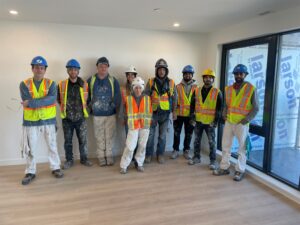Diversity and inclusion big focus at Twin City Painting

Twin City Painting recently developed a diversity and inclusion policy that explicitly outlines what behaviours are not acceptable in the workplace, encourages workers to come forward if they are on the receiving end of bulling or harassment, and indicates what behaviours are zero tolerance and will result in immediate termination of employment.
“We are an equal opportunity employer. We have people from all different origins, backgrounds, religions, ages, sexes, and we really like to try and make our workplace very inclusive and a safe place to be for all those different kinds of people,” said Christina French, project manager at the Dartmouth-based company. “We let our workers know that everybody is different but it’s important to treat others the way you want to be treated.”
The language barrier when some recent immigrants are hired has caused tension in the past. To mitigate this, Twin City Painting implemented a buddy program that pairs the new hire up with a willing current staff member to help them practice their English and learn some key terminology used in the trade.
“The buddy system has been highly effective at improving language skills for newcomers,” French said. “One individual has been with us for a year-and-a-half and his English is great — he does our work orders now!”
Respiratory protection
Spray painting is a serious hazard that can expose workers to toxic substance if not properly controlled. Twin City Painting recently sourced new respirators and developed a very detailed nine-page policy document around respiratory protection. It includes:
• a chart that outlines what chemicals the worker may be exposed to in a given job
• what respiratory protection and what filters and cartridges are needed for the task
• a standard job procedure for spray painting
• steps for properly putting on a respirator
• a diagram outlining what facial hair is and is not acceptable.
“Spraying paint is a big hazard with particles flying all around and we want to make sure our workers are very well protected,” said French. “The workers who use the sprayers undergo a respiratory fit test and are trained on how to put it on, take care of it, where to store it.”
Communication
The Twin City safety team is always encouraging staff to speak up and let them know about any safety concerns they may have.
“I believe communication is one of the most important parts of safety,” said French. “If they don’t feel comfortable communicating with us, how are we supposed to know what we need to change?”
All workers understand the importance of everyone on the job site being safe and that they have a duty to report any unsafe actions they see. If they report a co-worker who is working unsafely, they will be spoken to and be reminded about the “three strikes you’re out” policy. The first is a verbal warning, the second is written, and the third is a more serious discussion with management about the future of their employment at the company.
Constant improvement
Twin City Painting is certainly doing something right on the safety front, and the numbers speak for themselves: since January 2022, they have worked 93,000 hours and have logged zero hours missed from injury. In fact, the company only had three major injuries since its inception in 1979. French credits this success to the company’s commitment to constant improvement.
“We are making changes to our safety program pretty much all the time. We are always looking to improve and make changes where we need to,” she said.
Sometimes this constant change can be a bit difficult for some long-standing employees, but Twin City focuses on ensuring they do not underestimate the risk.
“We try to make sure they are educated on what could happen if they don’t do it. If you’re not wearing fall protection and you fall off something, you could kill yourself or get severely injured,” said French.
The company also tries to hit home how things are different now than before, for example, they are working at a much higher height now than they were in the ‘90s, so different safety procedures are required.
“That’s been our biggest challenge: workers who are used to how thing were back then,” said Christina. “But they have been doing well with it once we explain how things have changed and what can happen if you don’t work safe.”







